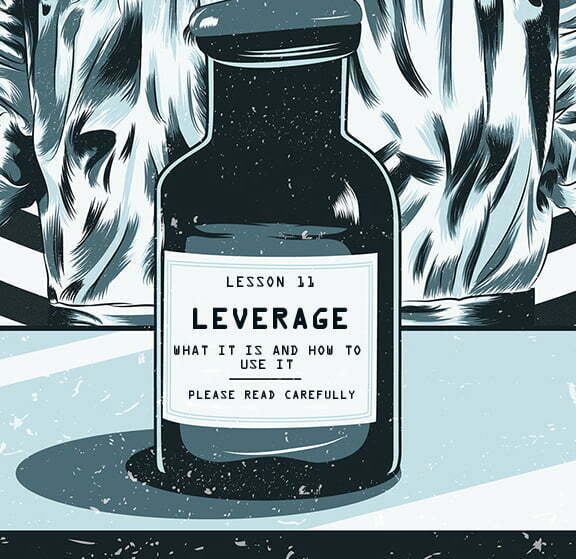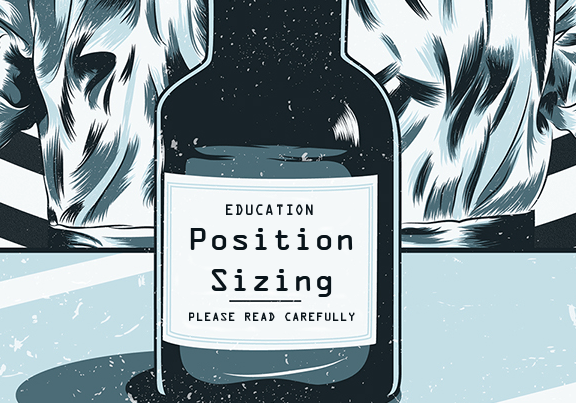Leverage — it’s one of those concepts that pretty much everyone in crypto is familiar with to some extent, even if it’s only from Twitter posts about people getting liquidated on insanely huge positions. But for most new traders, their understanding of leverage hardly goes beyond that, which is why their performance with it hardly ever goes beyond getting rekt.
You don’t want to be one of those people, but with the right knowledge, you don’t have to. Here’s a post with all you need to know about leverage: what it is, how it works, and how successful traders use it. With that said, let’s dive right in — from the basics on what leverage even is to practical details on how the pros use it.
Basically, leverage means trading with borrowed funds or through other financial instruments that enable you to open a position that’s worth more than your collateral. Think of it like this: when you’re trading spot, your max leverage is 1x: for every $1 on your account, you can buy $1 worth of a coin. Also, when you’re trading futures, you can also have an effective leverage of 1x or below, as long as you open a position that’s worth the same as your collateral or less.
“But I always choose 20x leverage,” I hear you say, “so how can it be less than 20x?” The thing is, when you’re trading on Binance Futures and choose 20x, that is the maximum leverage of your position, not the effective leverage. For example, let’s say you’ve got $1k on your Futures account and you only open one position worth $1k on Cross Margin. Your collateral is $1k and your position is $1k, so your effective leverage is 1x. The fact that you chose 20x in the menu only means that 20x is the maximum leverage you can get, and in this example, you can add up to $19k to your position size (or open other positions worth up to $19k).
This distinction between effective and maximum leverage is very important, and when you hear pro traders talk about how leveraged they are, they’re referring to effective leverage. New traders, on the other hand, will mistakenly say they’re leveraged 20x even if they’ve got a $100 position with $1000 collateral, as long as they chose 20x in the drop-down as their leverage (not knowing that this is max and not effective leverage, which is 0.1x in this case).
Now that we got that out of the way, let’s talk about how to use leverage. There are two main uses here: increasing position size and improving capital efficiency (while reducing exchange risk).
Increasing position size is the best known use of leverage: you open a position larger than your account balance so that you can make higher returns. But this also means that any drawdowns are also larger. For example: if you’ve got $100 of collateral and buy $100 worth of BTC on spot, and BTC goes up by 10%, you’ll make $10. On the other hand, if you open a position worth $1000 by using 10x leverage and it goes up by 10%, you’ll make $100 — a 2x instead of a 10% profit! But, if it goes down 10% while you’re leveraged 10x, you’ll lose the whole $100 instead of $10. In this scenario, you will be liquidated or — in other words — rekt, and you should avoid this at all costs.
That’s why an important rule is that you should never trade with leverage until you can be consistently profitable on spot. If you can’t make money without leverage, you won’t suddenly be profitable by going 20x. Instead, you’ll simply wipe out your account, and the only thing that will go 20x is the speed at which you will do that.
Still, if that does happen, don’t simply give up on crypto but use your experience as a lesson, get some money back into your account and start again with proper risk management (most traders blow up at least once before becoming successful, so don’t worry about it, but it is a hell of a lot easier if you skip that step).
The second use for leverage is capital efficiency, and this is how many pro traders use it. In fact, in an environment where assets can easily move 20–30+% per day, there’s hardly a reason to use leverage to increase your position size, unless you really know what you’re doing.
Increasing capital efficiency means that you can decrease the amount of money you hold on an exchange while still trading at the same position sizes. For example, instead of holding $100k on an exchange and trading spot with that money, you can move $90k elsewhere and still trade with the same position sizes by using leverage. There are many reasons why people do this — yield farming opportunities, better returns elsewhere etc. — but probably the most important one is exchange risk. The thing is, no matter how safe some exchange is, you should never have all your capital on any single exchange, and cold storage (getting a hardware wallet) is much better. So, to minimize risk, traders will often move a bunch of their capital to safer storage options and only keep a small amount on an exchange, while opening positions at their usual size by using leverage. That way, if the exchange gets hacked in the example above, you’d only lose $10k instead of $100k.
Conclusion
I hope this guide can help you get a grasp on what leverage is and how to use it like the pros do. I’ll do more posts on specific aspects of this, such as risk management, but for now, get out there, trade safe and don’t get rekt!






Risk Mngmnt n Position Size, they are d most significant items. You provided articles about them, but would be great if write more about them again, in detailed. We need a lot help to be master on these issues. Love,